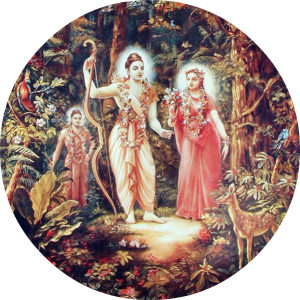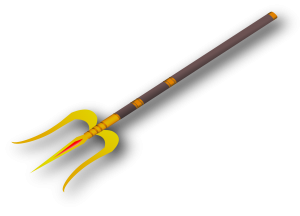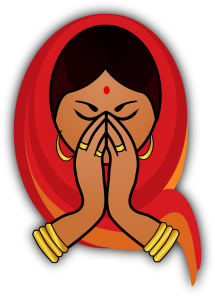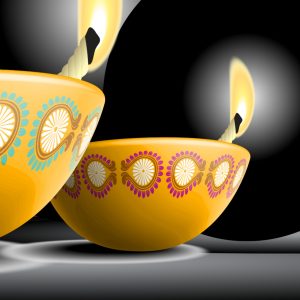
Lord Rāmacandra’s worship of Lord Śiva is an example of naravatagata-vicāra – a sweet, human-like pastime. As stated earlier, Rāma played the role of an ordinary human being who had to perform the difficult task of crossing the ocean to reach Laṅkā, and he worshiped Lord Śiva for the power to do this.
Lord Rāma established a liṅga of Rāmeśvara Mahādeva and began worshiping him, thinking, “By Lord  Śiva’s mercy I can cross the sea.” Actually he was powerful enough to personally jump across the ocean in a second, but he was playing a role to inspire ordinary people. The common people present considered that Rāmeśvara Mahādeva was in fact the lord of Rāma, and that was why his name was Rāmeśvara. The demigods then appeared and declared, “Rāmeśvara Mahādeva and Rāma are both the same. There is no difference between them. Both are īśvara; both are God, the
Śiva’s mercy I can cross the sea.” Actually he was powerful enough to personally jump across the ocean in a second, but he was playing a role to inspire ordinary people. The common people present considered that Rāmeśvara Mahādeva was in fact the lord of Rāma, and that was why his name was Rāmeśvara. The demigods then appeared and declared, “Rāmeśvara Mahādeva and Rāma are both the same. There is no difference between them. Both are īśvara; both are God, the
Supreme Lord. Ordinary people think only that Rāmeśvara is the lord of Rāma, but they are not intelligent. It is not like that.” At that moment Lord Śiva manifested from the liṅga and said, “No. Try to understand this truth. Rāmeśvara means ‘He whose Lord is Rāma.’ Rāma is my Lord!”
The pastimes of Lord Rāma are found in Rāmāyaṇa, Śrīmad-Bhāgavatam, the Purāṇas and Rāma-carita-mānasa, and they take place in a previous Age, called Tretā-yuga. The demonic king Rāvaṇa had kidnapped Lord Rāma’s wife, Sītā-devī, and taken her to Laṅkā. Before Rāma knew where Sītā had been taken, he was weeping profusely, and Lakṣmaṇa was trying to console him. The more Lakṣmaṇa tried to pacify him, however, the more bitterly he wept. In this state of mind, he was beseeching the trees and creatures of the forest, and even the Godāvarī River. He appealed to the trees of Panjātavi forest, “O Panjātavi, have you seen Sītā? Where has she gone? O deer, have you seen Sītā? O Godāvarī, have you seen my dear Sītā? Why has she left me?” Lord Rāma became maddened from inconsolable grief.
 At this time Lord Śiva and his wife Satī came to Daṇḍakāraṇya Forest, where Lord Rāma had been living with Sītā and His brother Lakṣmaṇa for fourteen years, following the order of His father, King Daśaratha. Śiva was thus present to witness Lord Rāma’s divine pastimes, and seeing them, he was moved; his heart melted. He offered full obeisances, with all the limbs of his body touching the ground, and glorified Rāma: “Oh! These pastimes are so beautiful and marvelous that they will melt the heart of anyone who sees them.” He then circumambulated the outer precincts of that area, weeping due to the transcendental emotions of grief in separation exhibited in his Lord’s pastimes.
At this time Lord Śiva and his wife Satī came to Daṇḍakāraṇya Forest, where Lord Rāma had been living with Sītā and His brother Lakṣmaṇa for fourteen years, following the order of His father, King Daśaratha. Śiva was thus present to witness Lord Rāma’s divine pastimes, and seeing them, he was moved; his heart melted. He offered full obeisances, with all the limbs of his body touching the ground, and glorified Rāma: “Oh! These pastimes are so beautiful and marvelous that they will melt the heart of anyone who sees them.” He then circumambulated the outer precincts of that area, weeping due to the transcendental emotions of grief in separation exhibited in his Lord’s pastimes.
Offering his final respects, Śiva was ready to return to Kailāsa, when
Satī asked him, “My dear husband, to whom are you offering obeisances?”
Lord Śiva replied, “Śrī Rāma is my worshipful Deity. I worship him always.”
Satī said, “I see that Rāma is like an ordinary man weeping for his wife. Even I know where Sītā is, but he does not know? Why is he grieving? He appears to be a weak person. Is he not strong enough to bring Sītā back? He must be an ordinary man, not God. Why are you honoring him so?”
“You are ignorant,” Lord Śiva told his doubting wife. “You do not understand that Rāma is the Supreme Personality of Godhead.” He told her that if she did not believe him she could conduct a test of some sort, to determine Śrī Rāma’s position.
Lord Śiva rested under a banyan tree a little distance away, and Satī, by her inherent mystic power, changed to a form like Sītā’s. She went to the area where Śrī Rāma was piteously searching for Sītā. She thought that if she would appear before Rāma as Sītā, he would come and embrace her in joyous relief, believing that he had found His wife. However, although she appeared before him again and again, He ignored her each time. He simply looked away. Finally he said to her, “Mother, why are you roaming alone here in the forest? Where is your husband, Śiva?”
Satī became astonished and fearful, and wondered how Rāma knew who she really was. She knelt in reverence, and at that time she no longer saw the trees, plants, and wildlife of the forest as before. She saw Sītā-Rāma everywhere and in everything. Wherever she looked in the forest – here, there and everywhere – she saw only Sītā-Rāma, Sītā-Rāma, Sītā-Rāma.
In this manner, Śrī Rāma showed Satī that he and Sītā are eternally inseparable, that he was performing this dramatic pastime to captivate the minds of human beings by its remembrance, and that he is, in fact, the Personality of Godhead. She reflected, “My husband is never ignorant. He was right and I was wrong.” Rising to her feet, she saw that Rāma was still there alone in the forest with Lakṣmaṇa, weeping, “Oh Sītā, where are you, where are you?”
Then, reassuming her own form, she returned to the spot where Śiva was waiting under the banyan tree. He asked her, “Did you test him to see who he is?”
Satī lied, “Most respected husband, I believed you; so there was no need to test him.”
Lord Śiva saw in a trance what had actually happened and silently vowed, “Satī has taken the form of Sītā, my mother; therefore she is no longer my wife. She is now my mother, and from now on I will treat her as such.”
 When he made this vow, the demigods at once showered flowers from heaven, and they praised him, “You have made a remarkable vow.” Satī asked, “What vow did you make?” Śiva remained silent.
When he made this vow, the demigods at once showered flowers from heaven, and they praised him, “You have made a remarkable vow.” Satī asked, “What vow did you make?” Śiva remained silent.
The bona fide disciple always has faith in his self-realized guru. Lord Śiva was the Guru of Satī, but she had not believed him when he told her that Rāma is the Supreme Personality of Godhead. If a disciple does not obey his gurudeva, his bhakti and spiritual life will diminish. If a disciple lies to his gurudeva, he again goes to hell.
When Lord Śiva and Satī-devī returned to their cottage in Kailāsa, Śiva placed her seat facing him. In Vedic culture a wife sits on the left side of her husband and a mother, respected as guru, sits in front of her son, facing him.
A disciple does not offer obeisance to his gurudeva from his guru’s right or left side, but always in front of him. A true disciple does not remain silent, but respectfully asks relevant questions of his guru and serves him. He does not ask questions in a challenging mood, but rather to learn. It is stated in Bhagavad-gītā (4.34):
tad viddhi praṇipātena
paripraśnena sevayā
upadekṣyanti te jñānaṁ
jñāninas tattva-darśinaḥ
Just try to learn the truth by approaching a spiritual master. Inquire from him submissively and render service unto him. The selfrealized souls can impart knowledge unto you because they have seen the truth.
Lord Śiva entered a trance for thousands of years, and Satī felt severe separation from him. She thought, “Śiva has left me. He is treating me like his mother because I took the form of Sītā. As long as I am in this body he will not accept me as his wife, so I will have to give up this body.”
After some time, Satī’s father Dakṣa, the son of Lord Brahmā and great progenitor of the universe, began a sacrifice. Although every sacrifice is intended to please the Supreme Lord Viṣṇu, all the demigods, especially Lord Brahmā, Lord Śiva and the other principal demigods, are invited and take part. However, Lord Śiva was not invited to Dakṣa’s sacrifice.
The chaste Satī heard the heavenly denizens, who were flying in the sky, speaking about the great sacrifice being performed by her father. She saw that the wives of the heavenly denizens, dressed in fine clothing, were coming from all directions and were going to the sacrifice. She approached her husband and said, “My dear Lord, your father-in-law is now performing a great sacrifice. All the demigods who were invited by him are going. If you desire, we may also go.”
Lord Śiva warned her not to go, due to her father’s enmity and envy towards him – an enmity that had begun long before, in a former Age. Lord Śiva now remembered his father-in-law’s harsh words spoken at that time. Śiva had come to Dakṣa’s council, where Dakṣa was being honored by many leaders of the universe. Dakṣa’s daughter was married to Lord Śiva, so he considered Śiva to be like his son. He offered obeisances to Brahmā because Brahmā was his father, but he did not show any respect to Śiva. Lord Brahmā welcomed Dakṣa, but Śiva was absorbed in meditation and chanting the mahā-mantra: “Hare Kṛṣṇa Hare Kṛṣṇa Kṛṣṇa Kṛṣṇa Hare Hare, Hare Rāma Hare Rāma Rāma Rāma Hare Hare.”
Insulted by Śiva’s apparent neglect and considering himself Śiva’s superior, Dakṣa publically criticized him. Many incidents took place as a result of that, and Śiva returned to Kailāsa. Previous to this, Dakṣa had often criticized Śiva, being disturbed that his daughter had married such an ‘inferior person’, but after this incident he considered Śiva his enemy. Lord Śiva, on the other hand, had never felt enmity towards Dakṣa.
Now Lord Śiva told Satī, “A woman can go without an invitation to see her guru or her father and mother, but if her father thinks that her husband is his enemy, then she should not go to see him. You know that your father thinks I am his enemy, although I have never considered him as such.”
Despite her husband’s words, Satī was determined to go. She went, but upon her arrival she observed Dakṣa dishonoring him. She angrily condemned her father and glorified Lord Śiva in front of all present. Then, while meditating on Lord Śiva’s holy lotus feet, she gave up her body in a mystic fire that manifested from her heart.
By quitting her body, Satī was able to disconnect herself from her offensive father and transfer herself to another body in order to associate with Lord Śiva without that contamination. However, her main motive was to become free from the result of her own offenses, and again be accepted as Lord Śiva’s beloved wife. In her next life she took birth as Pārvatī, the daughter of the Himālayas. In that birth she performed austerities for many years and achieved her desired goal.
Here we see that Śiva’s worshipable Deity is Rāma, and because Satī took the form of Sītā-devī, he left her. He is a chaste Vaiṣṇava, always serving Lord Kṛṣṇa and Lord Rāma. Satī-devī is also a pure devotee. She is the Supreme Lord’s divine energy, but she was playing a role in order to give lessons to ordinary persons.
Both Śiva and Satī served in Lord Rāma’s human-like pastimes. Rāvaṇa had not actually taken the real Sītā. He was not able to touch her. He could only take a māyā-sītā. The real Sītā, the transcendental potency of Rāma, was taken away and protected by the lord of fire, Agnideva. Rāma’s crying and asking each and every plant, tree, mountain and river, “Where is my Sītā?” was an exhibition of his human-like pastimes.
The great saint Tulsīdāsa has written in his Rāma-carita-mānasa that we should accept Śrī Śiva-Pārvatī as our Guru, and they will give us love for the lotus feet of Rāma. Those who worship Śiva as an independent lord are like Vṛkāsura. They want to have sense gratification with Kṛṣṇa’s potency. Instead of becoming Vṛkāsura, we should become devotees, and consider Śiva-Pārvatī as our Guru in the matter of devotion to the Supreme Lord.
Consider further the identity of Lord Śiva’s worshipable Deity. Śiva’s mantra is Rāma, and he always chants the holy name of Rāma. To whom does this refer? Although this also refers to Śrī Sītā-Rāma, the name he actually chants is that of Mūla-Saṅkarṣaṇa, Balarāma, the first expansion of Lord Kṛṣṇa. Śrī Rāmacandra is also an expansion of the original Rāma – Balarāma – but the factual worshipable Deity of Lord Śiva is Balarāma.
Ultimately, in the Hare Kṛṣṇa mahā-mantra, Rāma does not refer to
Daśaratha’s son Rāma, nor to Paraśurāma or Balarāma. Lord Rāmacandra, Lord Paraśurāma and Lord Balarāma are all manifestations of Śrī Rādhāramaṇa.
Hare Kṛṣṇa Hare Kṛṣṇa
Kṛṣṇa Kṛṣṇa Hare Hare,
Hare Rāma Hare Rāma
Rāma Rāma Hare Hare
The meaning of Rāma here is Rādhā-ramaṇa, Śrī Kṛṣṇa who engages in ramaṇa with Rādhā. Ramaṇa means playing or enjoying. Kṛṣṇa enjoys playful pastimes with Rādhārāṇī, and He is therefore called Ramaṇa or Rāma.
―Śrīla Bhaktivedānta Nārāyaṇa Mahārāja (Śiva-Tattva)
Image/Art made possible by Pixabay.com & Krishnapath.org







